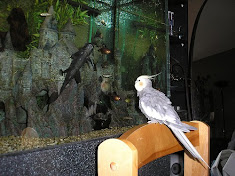 |
| Rhodesian Ridgeback by Ruben Edelman |
In about 1905 Cornelius Van Rooyen of Rhodesia began breeding what would become the modern Rhodesian ridgeback. He probably started with two female Hottentot ridgebacks, which he crossed with pointers, then added Airedales and Collies to the mixture. Greyhounds and Irish terriers are also thought to have entered the family tree at some point. The colonists noticed that those puppies born with ridges were loyal and made good protectors and hunting companions, so puppies with ridges were sought after and bred.
In 1900 Charles Robert Edmonds, an English veterinarian, arrived in Bulawayo, Africa, and met Van Rooyen's dogs. In 1923 he published an article entitled, "A Valuable Hunting Dog of Unknown Origin: Strong Characteristics."
In 1922 a standard defining the breed was set down by Edmonds and B.W. Durham, and it is still in effect. The standard is based upon that of a large Dalmatian. In 1924 the Rhodesian ridgeback was recognized by the Kennel Union of South Africa.
The dog was taken to Europe and the United States during the 1930's. In 1955 the American Kennel Club recognized the Rhodesian ridgeback breed, and the AKC has adhered to Edmond and Durham's breed standard. The breed is included in the hound group. In 1959 two Rhodesian ridgeback clubs were combined to form the Rhodesian Ridgeback Club of the United States.
Today the Rhodesian ridgeback is still used for hunting lions and other prey in southern Africa. In the United States, Canada, and Mexico, Rhodesian ridgebacks are used for hunting several species of animals. The list includes bobcats, lynxes, mountain lions, bears, coyotes, deer, wild boar and raccoons. Some have been trained to point to game and retrieve fowl and other game, but this dog breed still excels mainly in holding larger animals at bay until human hunters can shoot them.
These dog breeds are also used for hunting purposes in Australia, where it is sometimes used for flushing out birds and other small animals. In Europe the Rhodesian ridgeback can be a house pet, guard dog, watchdog, or police tracking dog. This relatively young but sturdy dog breed will undoubtedly be with us for many more years to come.
About the Author
Camille Goldin talks about the history and origin of Rhodesian Ridgebacks. She writes for TrainPetDog.com, a website that gives information on different Dog Breeds.



0 comments:
Post a Comment